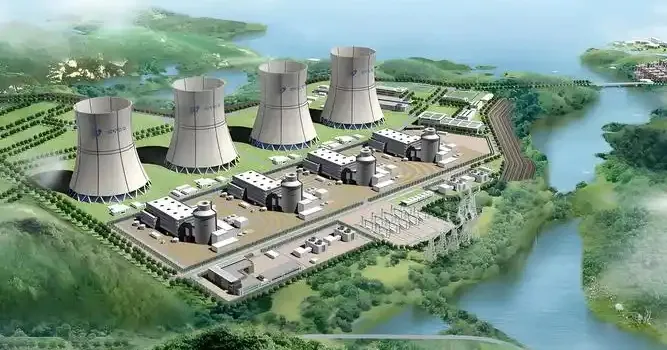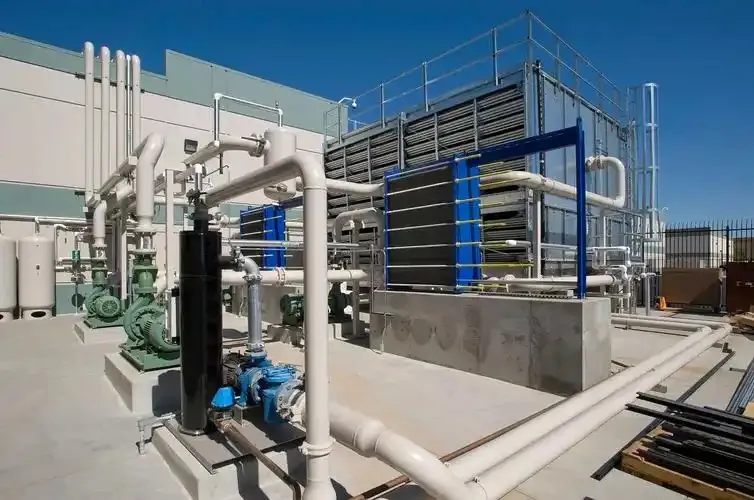Nuclear power, as a clean and efficient energy source, has been playing an increasingly important role in the global energy structure. During the operation of nuclear power plants, the cooling water system is of vital importance. Its stable operation is directly related to the safety and economic efficiency of nuclear power plants. Since most nuclear power plants are built in areas rich in water resources, such as coastal regions, seawater is often used as cooling water. However, seawater is rich in microorganisms, algae, and various marine organisms, which are likely to cause biofouling and corrosion problems in the cooling water system, seriously affecting the system's performance and the service life of equipment. As an effective means of sterilization, algae removal, and antifouling for cooling water, electrochlorination technology has been widely applied in the cooling water systems of nuclear power plants.

Principle of Electrochlorination Technology
Electrochlorination technology is based on the principle of electrochemistry. By electrolyzing chlorine - containing solutions (such as seawater or sodium chloride solutions), chlorine - containing substances with strong oxidizing properties, mainly sodium hypochlorite (NaClO), are generated to achieve the functions of sterilization, algae removal, and antifouling. Taking the electrolysis of seawater as an example, there is a large amount of sodium chloride (NaCl) in ionic form in seawater. Under the action of an electric field, the following electrochemical reactions occur:
Anode reaction: 2Cl⁻ - 2e⁻ → Cl₂↑
Cathode reaction: 2Na⁺ + 2H₂O + 2e⁻ → H₂↑ + 2NaOH
Since there is no diaphragm between the anode and the cathode, the chlorine gas (Cl₂) produced at the anode and the sodium hydroxide (NaOH) generated at the cathode undergo a secondary chemical reaction in the solution: Cl₂ + 2NaOH → NaCl + NaClO + H₂O
The overall reaction formula is: NaCl + H₂O -electrolysis-> NaClO + H₂↑
The generated sodium hypochlorite is a strong oxidant. The hypochlorous acid (HClO) produced by its hydrolysis can destroy the cell structure of microorganisms, oxidize the enzymes and proteins inside the cells, thereby inactivating the microorganisms and achieving the purpose of sterilization and algae removal. At the same time, sodium hypochlorite can also inhibit the attachment and growth of marine organisms, preventing biofouling.
Composition and Process of the Electrochlorination System
System Composition
- Electrolysis Device: It is the core part, consisting of an anode, a cathode, an electrolysis cell, and related circuits. The anode mostly uses a DSA anode coated with a titanium - based precious metal oxide, which has good electrochemical performance and a long service life. For example, it can operate stably within a temperature range of 5 - 40°C. The cathode is made of corrosion - resistant Hastelloy C - 276 alloy. Its low hydrogen evolution potential can reduce power consumption by 10 - 15%, and its surface is polished to reduce sediment deposition.
- Brine Preparation and Delivery System: If a sodium chloride solution is used for electrolysis, this system is required. It includes a wet salt storage tank, a concentrated brine pump, a dilute brine tank, a dilute brine pump, etc., which are used to prepare sodium chloride solids into solutions of appropriate concentrations and deliver them to the electrolysis device.
- Sodium Hypochlorite Storage and Dosing System: It stores the sodium hypochlorite solution generated by electrolysis and doses it into the designated locations of the cooling water system through dosing pumps. Usually, it is equipped with a sodium hypochlorite storage tank, a continuous dosing pump, and an impact dosing pump to control the dosing method and dosage according to the system requirements.
- Monitoring and Control System: It real - time monitors and controls parameters such as current, voltage, temperature, flow rate, and sodium hypochlorite concentration during the electrolysis process to ensure the stable and efficient operation of the system. An automated control system such as PLC is used to achieve remote operation and fault alarm.
System Process
Take the electrochlorination system of a typical nuclear power plant as an example. If seawater is used as the raw material: The seawater first passes through a primary automatic back - flushing filter to remove larger - sized particulate impurities, with a filtration accuracy of about 20 mesh. Then, it is pumped by a seawater pump to a secondary automatic back - flushing filter to further remove fine particles, and the accuracy is increased to 40 mesh. The treated seawater enters the sodium hypochlorite generation device, where sodium hypochlorite solution and hydrogen are generated by electrolysis under the action of direct current. The sodium hypochlorite solution flows into the sodium hypochlorite storage tank, and the hydrogen is naturally diluted to less than 1% in the storage tank and then discharged into the atmosphere. The sodium hypochlorite solution is continuously added to the forebay of the circulating water pump house through a continuous dosing pump, and the excess solution is stored in the storage tank. When the liquid level in the storage tank reaches the high - level alarm, the impact dosing pump is started in a linked manner to perform impact dosing on the water intake until the liquid level drops to the low - level, and then the impact dosing pump stops operating.
If a sodium chloride solution is used as the raw material, the process is different: First, sodium chloride solids are poured into the wet salt storage tank to make a saturated solution, which is then pumped by the concentrated brine pump to the dilute brine tank to be prepared into a low - concentration brine solution with a concentration of 28 - 36 g/L. The dilute brine pump pumps the low - concentration brine solution to the sodium hypochlorite circulation tank, and the sodium hypochlorite circulation pump is started to make the brine solution circulate and electrolyze between the circulation tank and the electrolysis device. After the specified electrolysis time is reached, the sodium hypochlorite solution enters the sodium hypochlorite storage tank and is dosed into each dosing point by gravity or a dosing pump.
Application Advantages of Electrochlorination Technology in Nuclear Power Cooling Water Systems
Significant Sterilization, Algae Removal, and Antifouling Effects
It can effectively kill various microorganisms, algae, and larvae of marine organisms in seawater, prevent their growth, attachment, and proliferation in the cooling water system, maintain the cleanliness of the system, ensure the heat transfer efficiency of the cooling water, and reduce the risk of equipment failure caused by biofouling. For example, after a certain nuclear power plant applied electrochlorination technology, the biofouling of the circulating water pipes and condensers was significantly reduced, and the equipment maintenance cycle was extended.
Low Operating Costs
Using seawater or sodium chloride as raw materials, the raw materials are widely available and inexpensive. Compared with other chemical treatment methods, the long - term operating costs are significantly reduced. For instance, compared with the traditional liquid chlorine addition method, electrochlorination technology does not require frequent procurement, transportation, and storage of liquid chlorine, reducing related costs and safety risks.
High Safety
There is no need to store and use highly toxic chemicals such as liquid chlorine, avoiding safety accidents caused by chemical leakage. The entire electrochlorination system operates in a relatively closed environment and is equipped with a complete set of monitoring and alarm devices, which can promptly detect and handle potential safety hazards.
Environmentally Friendly
The by - products of the electrochlorination process are mainly hydrogen and a small amount of precipitates, which have little impact on the environment. Compared with some chemical treatment methods, it reduces pollution to water bodies and the ecological environment, meeting environmental protection requirements.
Analysis of Practical Application Cases
Shandong Haiyang Nuclear Power Plant
The first - phase project of Haiyang Nuclear Power Plant consists of two 10 - million - kilowatt - class pressurized water reactor nuclear power units using the third - generation nuclear power technology AP1000 of Westinghouse Electric Company in the United States. The water treatment plant in the conventional island area adopts electrochlorination technology, and sodium hypochlorite is generated by electrolyzing a sodium chloride solution through an SMC - 1K type sodium hypochlorite generator. A front chlorine - dosing port is set before the clarifier, and a rear chlorine - dosing port is set before the raw water tank to control the growth of microorganisms. The chlorine generation system consists of a brine preparation and circulation system, a brine electrolysis system, a sodium hypochlorite storage and hydrogen discharge system, a dosing pipeline, and an acid - cleaning system. Operational practice shows that this technology effectively guarantees the quality of raw water, avoids the impact of microorganisms on subsequent demineralized water treatment processes, and the system operates stably and reliably.
Units 5 and 6 of Fuqing Nuclear Power Plant (Hualong One)
Qingdao Sunrui Company supplied, installed, and commissioned the seawater electrolysis chlorine - generation system for Units 5 and 6 of Fuqing Nuclear Power Plant. After the system was installed and put into operation, it can promptly stun or kill the larvae and spores of marine organisms in the circulating water, protecting the circulating water pipes and condensers. In order to ensure the success of the commissioning, a special plan was formulated to overcome various unfavorable factors. After more than 50 days of efforts, the one - time power - on commissioning was successfully completed, providing an important guarantee for the safe and stable operation of the units and ensuring the normal operation of the circulating water system and the entire units.
Challenges and Countermeasures in Application
Electrode Scaling Problem
During the electrolysis process, calcium, magnesium, and other ions in seawater may form precipitates on the electrode surface, leading to electrode scaling, an increase in cell voltage, a decrease in current efficiency, and an increase in power consumption. The countermeasure is to regularly perform acid cleaning on the electrodes. A hydrochloric acid solution with a concentration of about 10% is used as the cleaning solution, and the acid - cleaning cycle is determined according to the actual operation situation. For example, a certain nuclear power plant sets the acid - cleaning cycle to about 750 hours. At the same time, the design of the electrolysis cell is optimized to increase the turbulence of seawater in the electrolysis cell and reduce sediment attachment.
Hydrogen Safety Problem
Hydrogen is generated during the electrolysis process. If hydrogen accumulates in the system, it may cause an explosion hazard in case of open flames. Through a perfect hydrogen discharge system, hydrogen is promptly discharged outdoors, and a hydrogen concentration monitoring device is installed in the system to ensure that the hydrogen concentration is always lower than the explosion lower limit. For example, the hydrogen concentration in the sodium hypochlorite storage tank is controlled to be less than 1%. In addition, explosion - proof electrical equipment is used in the system to avoid the generation of electrical sparks.
Control of Sodium Hypochlorite Dosing Amount
If the dosing amount is too low, it cannot effectively inhibit the growth of organisms; if the dosing amount is too high, it may cause equipment corrosion and have an adverse impact on the environment. An advanced monitoring and control system is used to adjust the sodium hypochlorite dosing amount in real - time according to the quality, temperature, flow rate of the circulating water, and the growth of organisms. For example, during normal operation, the continuous dosing amount is 1 ppm. When the growth of marine organisms is severe, impact dosing is also used, with an impact dosing amount of 3 - 5 ppm, an impact dosing time of 0.5 hours each time, and three impact dosings per day. At the same time, the residual chlorine in the circulating water discharge is controlled at 0.1 - 0.5 ppm.
Conclusion

With its unique advantages, electrochlorination technology plays a crucial role in the cooling water systems of nuclear power plants, effectively solving the problems of biofouling and corrosion in the cooling water systems and ensuring the safe, stable, and efficient operation of nuclear power plants. Although there are some challenges in the application process, these problems can be effectively solved through continuous optimization of system design, improvement of operation management, and the adoption of advanced technical means. Chlory company has been dedicated to the research and development of electrochlorination technology, With the further development and improvement of the technology, the application prospects of electrochlorination technology in the nuclear power field and other industrial cooling water systems will be broader, providing strong support for promoting the sustainable development of the energy industry.
